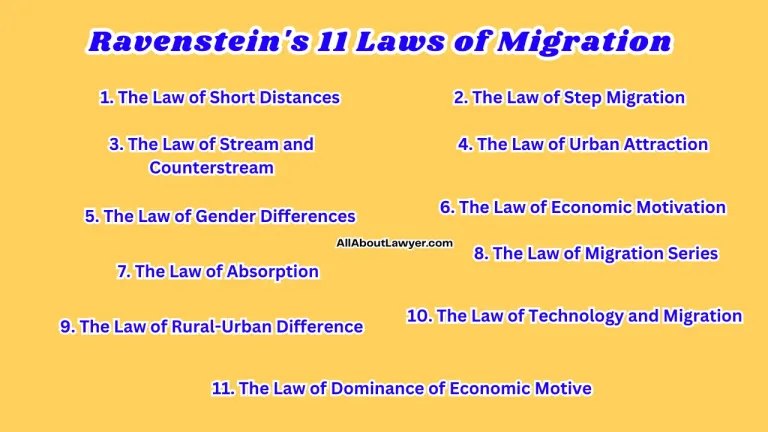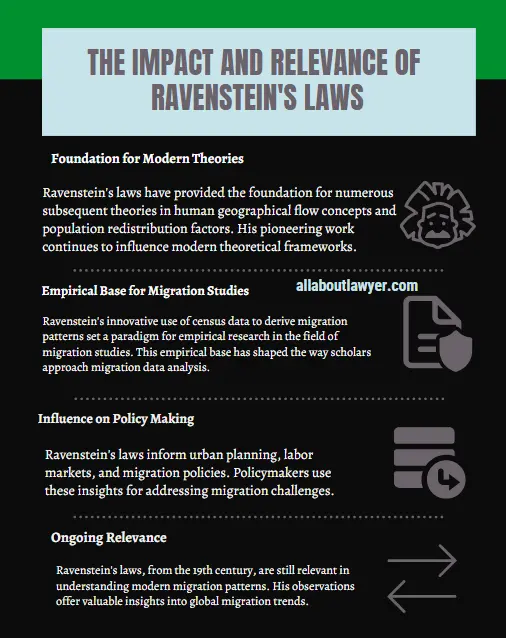What Are Ravenstein’s 11 Laws of Migration Exploration of Population Relocation Theories
Imagine a bustling city in the late 19th century, where thousands of people are arriving each day, seeking jobs, better living conditions, or simply a fresh start. This scenario wasn’t just a reality in Victorian England, but a phenomenon unfolding across the globe as the Industrial Revolution transformed societies. It was during this time that a British-German geographer, Ernst Georg Ravenstein, made a groundbreaking attempt to answer a simple yet profound question: Why do people move?
In 1885, Ravenstein formulated what would become known as the 11 Laws of Migration, a series of observations based on census data and patterns of migration. These laws would lay the foundation for modern human geography, shedding light on the forces that drive people to leave their homes and settle elsewhere. Over a century later, Ravenstein’s principles remain incredibly relevant: in 2020 alone, the number of international migrants reached a staggering 281 million—representing 3.6% of the global population.
This article delves into Ravenstein’s 11 Laws of Migration, exploring the insights they offer into historical and contemporary patterns of human movement, and why they still hold significance in today’s increasingly interconnected world. Whether you’re a student of geography, a researcher, or simply curious about what motivates migration, Ravenstein’s theories provide a timeless framework to understand the ebb and flow of human populations.
Table of Contents
The Historical Context of Ravenstein’s Work
Before we examine the individual laws, it’s crucial to understand the context in which Ravenstein developed his theories. As a German-English geographer in the 1880s, Ravenstein was witnessing unprecedented societal migration factors driven by industrialization and urbanization. His work, primarily based on census data from England and Wales, sought to identify patterns in these population relocation rules.
Ravenstein’s 11 Laws of Migration | An Overview
While Ravenstein’s work has been interpreted and categorized in various ways over the years, the following list represents the most commonly cited version of his 11 laws:
1. The Law of Short Distances
This fundamental principle states that the majority of migrants only move short distances. It reflects the natural human tendency to minimize disruption and maintain familiar connections. In modern terms, this law still holds true in many internal migration scenarios, particularly in urban-rural migration dynamics.
2. The Law of Step Migration
Ravenstein observed that migration often occurs in stages. People might first move from rural areas to nearby towns, then to larger cities, and potentially even to other countries. This concept of gradual geographical redistribution patterns remains relevant in understanding contemporary migratory behavior theories.
3. The Law of Stream and Counterstream
For every major migration stream, Ravenstein noted a counterstream. While people move from one area to another, there is also a flow in the opposite direction, albeit usually smaller. This principle highlights the dynamic nature of population displacement patterns and is evident in phenomena like return migration.
4. The Law of Urban Attraction
Cities, with their economic opportunities and social amenities, tend to attract more migrants than rural areas. This law underscores the significant role of urbanization in shaping demographic shift hypotheses and remains highly relevant in understanding global patterns of internal migration.
5. The Law of Demographic Differentials
Ravenstein observed that different demographic groups have varying propensities to migrate. For instance, he noted that women were more likely to engage in short-distance migration, while men were more prone to long-distance moves. While gender dynamics in migration have evolved, demographic factors continue to influence migration patterns.
6. The Law of Economic Motivation
Economic factors, such as better job prospects or higher wages, are primary drivers of migration. This principle aligns with many modern economic migration motivators and continues to be a cornerstone of migration studies.
7. The Law of Absorption
Ravenstein posited that migration leads to the growth of great centers of commerce and industry. This law reflects the cumulative nature of migration, where existing population centers attract more migrants, leading to further growth.

8. The Law of Migration Series
This law suggests that migration moves in a series of stages, often following established routes. It ties into the concept of chain migration, where migrants follow pathways established by earlier migrants from their community.
9. The Law of Rural-Urban Difference
Ravenstein noted that urban residents are less likely to migrate than rural dwellers. This observation reflects the economic and social factors that often drive rural-to-urban migration.
10. The Law of Technology and Migration
Improvements in transportation and communication facilitate increased migration. In Ravenstein’s time, this referred to developments like railways, but today it encompasses a wide range of technological advancements in migration.
11. The Law of Dominance of Economic Motive
While various factors influence migration, Ravenstein emphasized that economic considerations tend to dominate. This principle underscores the importance of socioeconomic migration drivers in shaping population movements.
The Enduring Impact of Ravenstein’s Laws
Ravenstein’s laws of migration have had a profound and lasting impact on the field of population studies and human geography:
1. Foundation for Modern Theories: Many contemporary theories of spatial demographic transition laws build upon Ravenstein’s work.
2. Empirical Approach: Ravenstein’s use of census data set a precedent for empirical research in migration studies.
3. Policy Implications: Understanding these laws has informed policies related to urban planning, labor markets, and international migration.
4. Interdisciplinary Relevance: Ravenstein’s work has influenced fields beyond geography, including sociology, economics, and political science.

Contemporary Applications of Ravenstein’s Laws
Despite these limitations, Ravenstein’s principles continue to inform modern migration studies:
1. Economic Models of Migration: Many contemporary economic theories of population movement build upon Ravenstein’s emphasis on economic factors.
2. Push-Pull Theory: The idea that migration is influenced by push factors in the place of origin and pull factors in the destination can be traced back to Ravenstein’s work.
3. Gravity Models of Migration: These models, which consider both population size and distance in predicting migration flows, build upon Ravenstein’s observations.
4. Environmental Migration: While not explicitly addressed by Ravenstein, his laws provide a framework for understanding migration driven by environmental pressures.
The Future of Migration Studies | Building on Ravenstein’s Legacy
As we face new challenges in the 21st century, from climate-induced migration to global economic shifts, Ravenstein’s laws continue to provide a valuable foundation for understanding human geographical flow concepts. Future research in migration studies is likely to:
1. Incorporate big data and advanced analytics to refine our understanding of migration patterns.
2. Explore the impact of climate change on population redistribution factors.
3. Examine the role of social networks and information technology in shaping migration decisions.
4. Investigate the intersection of migration with other global trends, such as aging populations and urbanization.
Conclusion
Ravenstein’s 11 laws of migration, formulated over a century ago, continue to offer valuable insights into the complex phenomenon of human movement. While the world has changed dramatically since Ravenstein’s time, the fundamental principles he identified – from the preference for short-distance moves to the economic motivations behind migration – remain relevant in many contexts.
As we continue to grapple with the complexities of global migration in the 21st century, Ravenstein’s work serves as a reminder of the enduring patterns in human behavior and the importance of empirical observation in understanding these patterns. By building upon and adapting these foundational theories, we can continue to develop more nuanced and comprehensive understandings of migration in our ever-changing world.
Related Articles For You:
How Many of Ravenstein’s Laws of Migration Exist?
What Are Ravenstein’s 5 Laws of Migration?
FAQs
Are Ravenstein’s laws of migration still relevant today?
Yes, while the specifics may have changed, the fundamental principles identified by Ravenstein still provide valuable insights into migration patterns and serve as a foundation for modern migration theories.
Did Ravenstein consider forced migration in his laws?
Ravenstein’s laws primarily focused on voluntary migration driven by economic factors. However, some of his principles can be applied to understand certain aspects of forced migration, though this type of movement often follows different patterns.
About the Author

Sarah Klein, JD, is a legal writer with experience in immigration and migration law, covering topics like green cards, marriage-based visas, and asylum applications. Through All About Lawyer, she provides straightforward legal insights to help individuals and families navigate complex immigration processes with clarity and confidence.
Read more about Sarah
